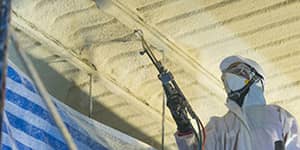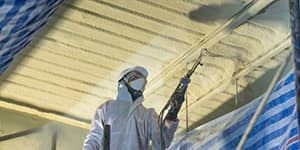St Louis - St Charles Keep Cool.


What is the Best Insulation for a Flat Roof?
If you have a flat roof, whether for your home or your business, you may wonder if the insulation you have right now is sufficient, or if you should have it replaced. If you’re a builder or contractor constructing a flat roof, you may wonder which insulation would work best in this application.
Flat roofs are notorious for their challenges in construction. They can be difficult to maintain, waterproof and, yes, insulate. Choosing the wrong insulation in St. Louis MO can lead to leaks, energy inefficiency and more. There are a few factors to consider.
Insulation: Ceiling Rafters
To insulate between ceiling rafters, there are two main types that are best: spray foam (closed or open cell) insulation or affordable dense-pack cellulose insulation It’s tough to properly insulate and ventilate flat spaces since air doesn’t always move in a linear fashion. This allows moisture to get into small spaces, which can then become trapped.
Therefore, it is often easier to start with a non-ventilated area and either fill the cavity with cellulose, or seal it up with about five inches or so of spray foam.
You’ll have to consider rafter height, of course. For 2x6 rafters, closed cell spray foam is your only choice due to R-value restrictions. If you have 2x8s, dense pack cellulose or open cell spray foam would work best.
Insulation: Exterior Roof Surface
Commonly used for commercial flat roofs, a strong adhesive can be applied to the foam board, followed by a rubber waterproof membrane as needed to achieve the desired R-value. You’ll need to insulate the rim joists to prevent moisture and air filtration problems.
Insulation: Ceiling
Last but not least, this option is not widely recommended due to the need to drop the ceiling to maintain code requirements. This option also makes it difficult to add lighting or hardware later on.
With so many limited options for insulation, you can see why flat roofs are not a desirable roofing type, especially for residential use.
Knowing which insulation to add for your home or business is critical. For traditional roofs with eaves and dormers, the go-to option by many today is spray foam. That’s because it can easily be applied to the spaces between attic rafters. Not only does this act as a moisture barrier, it can provide a high R-value for optimal energy efficiency.
Fiberglass batt insulation has historically been the go-to choice to add between attic rafters, but it is being overtaken in popularity by modern methods of roof insulation. That’s because fiberglass insulation tends to compress and lose R-value over time, and is quite inefficient at stopping air from getting into and out of your house.
If your home has a flat roof and you’re unsure which insulation to go with, get in touch with your trusted insulation contractors in St. Louis MO.
Addict Insulation Has Energy Saving Solutions
To make an appointment with your St Louis & St. Charles MO insulation specialist, contact us at 636-233-7314.
Energy Saving BlogCommercial & Residentail Insulation Company
Popular Articles
- FAQs About Insulation in Missouri
- What Areas Should You Insulate Before Winter?
- The Greatest Risks to Your Home Caused by Poor Insulation
- Why Your Utility Bills Are So High and What You Can Do About It
- Can You Put New Insulation Over Old?
- Here Are 3 Ways Your Attic Could be Contaminated
- How Home Insulation Works in the Summer
- Tips and Tricks For Summer Insulation
- How to Fix Indoor Condensation
- Choosing the Right Spray Foam Contractor
- Why You Need Power Washing This Spring
- Don't Let Air Escape Your Home
- Tips For Saving on Your Energy Bills This Summer
- Should I Install a Radiant Barrier in My Home?
- Are You Wondering if Your Attic Has Enough Insulation?
- Do I Have to Replace Wet Insulation?
- Insulating Your Sunroom
- Should You Insulate Your Outdoor Spaces?
- All About Removing Insulation
- What to Know About Insulating a Crawl Space
- How to Spot Mold in Your Wall Insulation
- How to Prevent Moisture in Your Warehouse With Spray Foam Insulation
- What Factors Cause Heat Gain?
- The Problems That Come With Improper Insulation
- Insulation FAQs
- Why Should You Check the Insulation When Buying a Home?
- Why Seal and Insulate Your Home?
- Home Insulation: Safety and Health
- Should You Remove Old Insulation During Replacement?
- Can I Stay Inside My Home During Spray Foam Insulation Installation?
- Pros and Cons of Converting an Attic
- Pros and Cons of Converting an Attic
- When’s the Best Time to Insulate Your House?
- The Difference Between Blown Insulation and Spray Foam Insulation
- Is Your Garage Loft Too Hot or Too Cold? Heed These Tips
- 6 Health Benefits of Having a Quiet Home
- Insulation Prep is Critical For Installation
- The Dangers of Removing Insulation on Your Own
- What’s the Most Eco-Friendly Insulation?
- 7 Benefits of Spray Foam Insulation
- What is the Proper Insulation For Vaulted Ceilings?
- Signs Your Crawlspace Insulation Should be Replaced
- Why You Should Insulate Your Basement Walls
- Most Effective Ways to Soundproof Your Home Office
- How to Insulate an Old House
- 4 Tips to Make Your Attic More Energy Efficient
- Attic Insulation Problems: 5 Things to Look Out For
- What Causes Condensation on Interior Walls?
- How Deep Should Your Insulation Be?
- What to Consider When Choosing an Insulation Company
- Can You Add New Insulation Layers Over Old Ones?
- When Should You Remove Insulation?
- 7 Tips For an Energy Efficient Summer
- Creating a Healthy, Comfortable and Productive Workspace When Working From Home
- Why is Roof Ventilation Just as Important as Insulation?
- Why Spring is a Good Time to Insulate Your Attic
- 5 Signs of Damaged or Insufficient Insulation
- Is the Insulation in Your Walls Making You Sick?
- Under-Insulated Areas You May Be Overlooking
- The History Of Insulation.
- Pros and Cons of Attic Insulation
- Do You Need Insulation When Finishing a Basement?
- What is Drill and Fill Insulation?
- Which Insulation is Best for Garage Walls?
- How Air is Escaping Your Home and How to Prevent It
- 10 Things You Must Absolutely Insulate Before Winter
- 5 Reasons To Not DIY Insulation
- 5 Signs of an Under-Insulated Home
- 5 Benefits of Blown Insulation
- Cellulose vs. Fiberglass Insulation
- When is Insulation Removal Necessary?
- Tips to Keep Your Home Cool This Summer
- What is the Best Insulation for a Flat Roof?
- 5 Benefits of Power Washing
- Q & A About Insulation
- Reviews
- Energy Saving Blog






